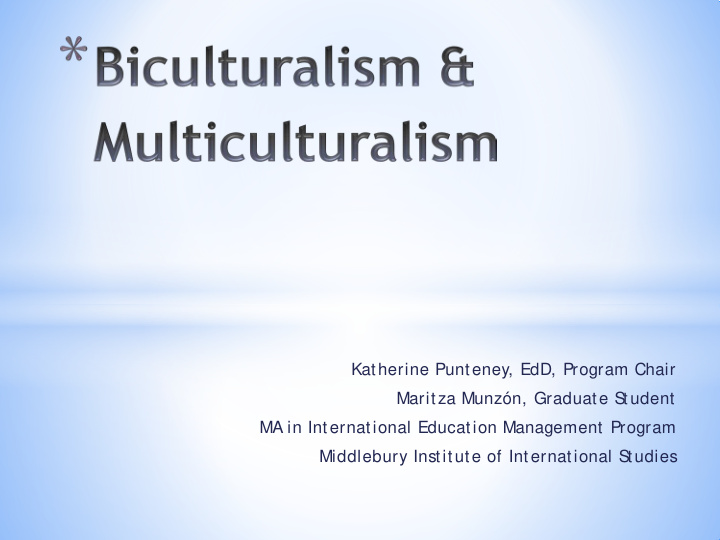



Katherine Punteney, EdD, Program Chair Maritza Munzón, Graduate S tudent MA in International Education Management Program Middlebury Institute of International S tudies
Make groups of 4 Choose one person t o writ e for t he group Chicana MARITZA The writ er writ es each person’s name on one card Each person t hinks of t wo more aspect s of ident it y t hey are willing t o share and t ells t he writ er Consider: The writ er writ es on t he cards Ethnicity, Gender Identity, S exuality, Political Affiliation, All of t he cards go back int o Nationality, Religion, Age, Hobby, etc. t he envelope and get mixed t oget her
Part 2: Exchange envelopes with another group ? In your group, try to match the MARITZA other groups members’ names with their identities Don’ t talk to the other group ----------------------- Important: Once both groups are done, share Y ou only need to reveal what you wrote on the cards. your guesses with each other Tell them whether they are S o, if the other group thought you wrote that you are Jewish, you only correct or not, and tell them have to tell them if it’s your card or which cards are yours not, not what your religion is.
? Discussion: How did t his act ivit y feel? What was it like t o label ot hers? To be labeled? How did you decide how t o label people?
Biracial Kids Immigrants Expatriates Foreign Service Missionaries Minorities Family Third Culture Military Family Refugees Kids Adapted from: Van Reken, R. E. (2011). Cross-cultural kids: The new prototype. In Bell-Villada, G. H., S ichel, N., Eidse, F . & Orr, E. N. (Eds). Writ ing out of limbo: Int ernat ional childhoods, global nomads and t hird cult ure kids . (pp 25-44). Newcastle upon Tyne: Cambridge S cholars Publishing.
S ource: Anzaldúa, G. (1999). Borderlands-La Front era: The New Mest iza . S an Francisco: Aunt Lute Books.
Marcia’s Ego Identity Statuses * Foreclosure (No identity crisis/commitment) * Accept parental values without questioning; might be in homogenous environment * Moratorium (Identity crisis/ no commitment) * Actively questioning parental values; vacillating, may be anxiety-ridden * Identity Achievement (Past identity crisis/ commitment) * Comes after period of identity crisis; individual has sorted through alternatives and made a strong choice of identity * Diffusion (No identity crisis/ no commitment) * Refusing or unable to commit to an identity; tend to conform and be submissive to external expectations * S ource: Evan, N.J., Forney, D.S ., Guido, F .M., Patton, L.D. & Renn, K.A. (2010). Psychosocial identity development. S t udent Development in College: Theory, Research, and Pract ice . S an Francisco: Jossey-Bass.
Patterns of Identity among Multiracial College Students * Monoracial: choosing one identity * Multiple Monoracial: holding one identity at a time, but shifting identities based on time and place * Multiracial : considering ‘ multiracial’ to be a distinct classification and identity of it’s own * Extraracial: opting out of any identification with race categories * Situational: shifting between the some of the other four identities in different contexts S ource: Renn, K. A. (2008). Research on biracial and mult iracial ident it y development : Overview and synt hesis. New Direct ions for S t udent S ervices, 123. 13-21.
Divide int o small groups: Each group reads a st ory excerpt writ t en by a bicult ural/ mult icult ural person. Discuss: How does t he st ory relat e t o t he labeling act ivit y we did? How does t he st ory relat e t o t he t heory we int roduced? Choose 1-2 sent ences from your st ory t o read aloud t o t he whole group.
Recurring themes in the stories of bicultural/ multicultural individuals: * People always ask “ Where are you from? ” and mean “ What are you? ” * Labels are often imposed by others * Trying to explain and j ustify your identity constantly * Pressure to assimilate * Coming to terms with identity can be painful * Feeling like you are not enough is common * There can be comfort in choosing not to define yourself * Developing your own label, making your own term
Recurring themes in the stories of bicultural/ multicultural individuals: * Attraction between people of minority groups to each other * Lack of sense of belonging except with other “ non-belongers” * Code-shifting as you go back and forth between cultures * Exploring your heritage * Periods of experimenting with trying on identities * Periods of rej ecting parts of your identity * Moving from negative emotions to acceptance * Valuing the advantages of biculturalism/ multiculturalism * Identity is always changing and evolving
Half & Half O’ Hearn, C.C. (1998). Half and half: Writers on growing up biracial and bicultural. New Y ork: Pantheon. Writing Out of Limbo Bell-Villada, G.H., S ichel, N., Eidse, F . & Orr, E.N. (2011) Writ ing out of limbo: Int ernat ional childhoods, global nomads, and t hird cult ure kids . Newcastle upon Tyne: Cambridge S cholars. What Are You? Gaskins, P . F . (1999). What are you? Voices of mixed-race young people . New Y ork: Henry Holt and Company. Unrooted Childhoods Eidse, F . & S ichel, N. (2004). Unroot ed childhoods: Memoirs of growing up global . Y armouth, ME: Intercultural Press.
*
Recommend
More recommend